
The Pirate Surgeon's Quarters: 1 2 3 4 5 6 7 8 9 10 11 12 Next>>
The Pirate Surgeon's Quarters in the Golden Age of Piracy, Page 4
Pirate Vessels: Small Craft
"... they steered for the coast of Virginia, and in their way, met with a large New-England brigantine, laden with provisions, bound for Barbados. This they made prize of, and shifting their own guns on board her, sent the master away in the sloop, after forcing some of his men with them. They had now a vessel of ten guns, and a crew of 80 men, of whom one [John] James was captain, and [Thomas] Howard quarter-master." (Daniel Defoe (Captain Charles Johnson), A General History of the Pyrates, Manuel Schonhorn, ed., 1999, p. 488)
Many pirates who were located in the Caribbean operated smaller, single- and double-masted ships during the golden age of piracy. Some of those who graduated to larger ships started their careers in smaller ships, gradually working their way up as their manpower and number of guns grew. This allowed them to take larger ships and keep them when they suited their purposes. Below are the 98 different pirate/small ship combinations found in the period data under study.
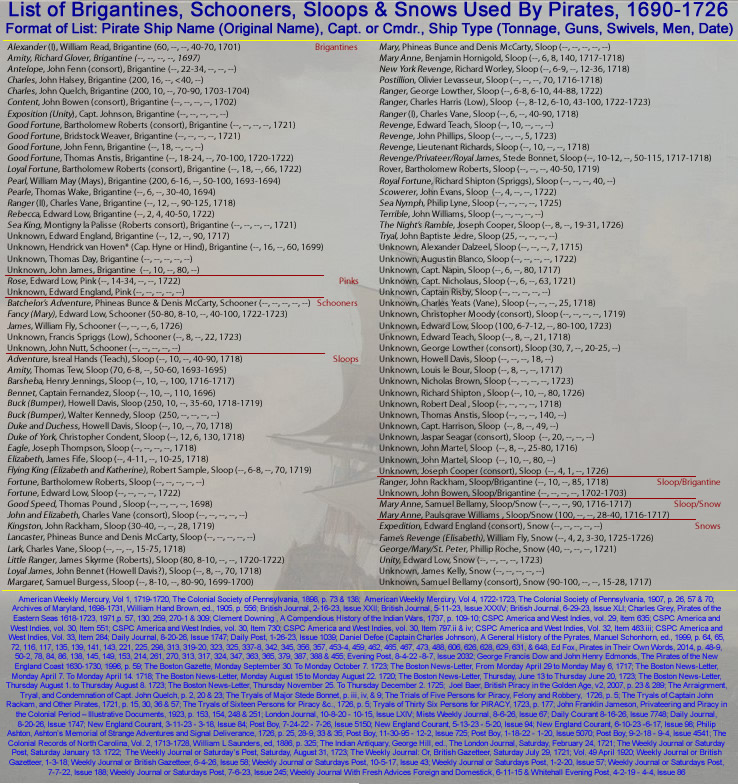 Small Vessels in Use by Pirates During the Golden Age of Piracy Based on Period Sources |
This list is organized first by vessel type (which appears in dark red to far the right of the list and then in alphabetical order by ship name and captain name. A couple of points about the data in the list are worth mentioning, most of which are the same as those for the Large Ship List on the previous page. First, when numerical data was not available for the tonnage (burden), large guns or cannon, swivel guns, men or years in which the data source indicates the vessel was used, the symbol '--' appears as a placeholder. Second, the dates shown may not necessarily represent the entire life of the vessel as a pirate; this is is based strictly on the information found in sources which were used to make up the list. Finally, there are four vessels identified as being of two different ship types which have been given their own category.
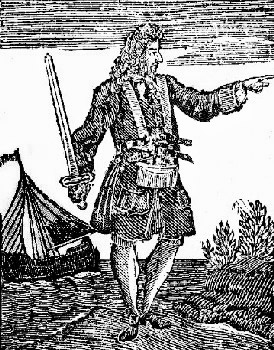
Charles Vane in front of his Sloop Ranger
from The General History of the Pirates
(1724)
Many of the vessels found in the West Indies (including the Caribbean and the New England coast) in the later part of the golden age of piracy were small vessels. Historian Angus Konstam explains that "the majority of the coastal vessels that plied the waters of the Atlantic seaboard or the Caribbean displaced less than 100 tons."1 This was in part because these ships were better suited to that environment. This fact was to frustrate the Royal Navy who typically sent larger fifth or sixth rate station ships to the West Indies to fight the pirates. Captain Peter Pickard of the 36 gun fifth rate Saudadoes Prize complained "Its almost all together impossible to think of catching of them unless had sutch vessells as theirs are, vizt. sloopes and brigeentins, for they keep near shore and run amongst should [shoals] that we darest not follow them without hazarding the shipp."2
Still, pirates were always on the lookout for a better ship. While this sometimes referred to a interest in trading up to a larger ship, it might also simply refer to one which was better (or with a cleaner hull) for the purpose. Pirate captain William Fly explained to the master of a captured sloop, he must "make bold to try if Capt. Fulker's sloop was a better sailer than [his] snow. If she was, she would prove much fitter for their business, and they must have her."3
Smaller boats had several advantages - speed, maneuverability, ease of careening and a shallow draft which allowed them to sail in in places where larger ships could not. These characteristics varied between vessels as Fly's statement attests. One reason small vessels were popular among golden age pirates in the Caribbean and Colonies was because they were popular in those areas and easier for a small crew of pirates to intimidate. Smaller vessels required smaller crews, in part because most merchants staffed their ships with the minimum number of men in an effort to save money. So the pirates found it easier to capture them.
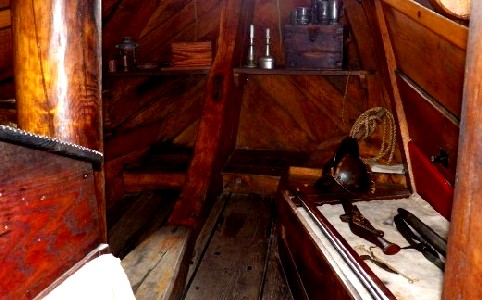
Photographer: Michael Lamonica
Cockpit of the Duyfken Replica. Although this is a 1606 ship and larger than a sloop it gives
an idea of the surgeon's cramped quarters.
By definition, smaller vessels had less space in them, which meant there was less accommodation for ship's surgeons. However, there are several examples of surgeons working for pirates in such vessels. William Parker served as surgeon aboard Thomas Anstis' brigantine Good Fortune.4 An unnamed French surgeon was stationed on John Phillips' sloop.5 Another unnamed surgeon was aboard Joseph Cooper's sloop The Night's Ramble.6 One of Bartholomew Roberts' surgeon, Peter Scudamore, served on his Ranger sloop. Scudamore didn't actually remain there, however, because he was elected to be the Chief Surgeon "by the good Will of the Ranger's People, who, in general, voted for Scudamore, to get rid of him, (the chief Surgeon being always to remain with the Commodore [ on board Bartholomew Robert's ship the Royal Fortune].)"7 At that point he was probably replaced by one of Roberts other two or three surgeons.
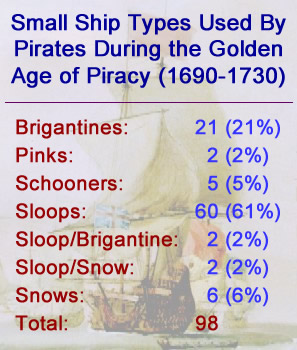
Small Ships in the Data By Type, Background Image by
Peter Monamy of a British Sloop (1720-1730)
As with large ships, the surgeon's place on a sloop would typically be on the lowest deck. Like the men, he would likely find his quarters overcrowded, which would be exacerbated by having to share his space with everything required for the vessel's care and maintenance, any cargo or treasure that the boat might be hauling and possibly even cannon.
The breakdown for the vessel types is shown in the chart at right. This includes both the number of times each vessel/captain combination appears in the data as well as how big a part of the data each type is by percentage. While this makes the vessel types look simple, the data is actually a bit more complex than it appears. Broadly speaking, the different types of small craft fall into two categories - those with different sail plans, which include brigantines, schooners and snows, and those with different hull types, which includes pinks and sloops. This explains why the two hybrid categories make sense - they describe both the hull type and sail plan. It may explain why Charles Johnson identifies a ship taken by pirates Phineas Bunce and Denis McCarty as being both a schooner and a sloop in his text.7 The discussion of the individual small vessel types will begin by looking at the craft defined by their sail plans and then finish with a look at those with different hull types.
1 Angus Konstam, The Pirate Ship 1660 -1730, p. 23; 2 Peter Earle, The Pirates Wars, 2003, p. 151 & "British Fifth Rate ship 'Saudadoe's Prize' (1692)", threedecks.org website, gathered 12/24/18; 3 Daniel Defoe (Captain Charles Johnson), A General History of the Pyrates, Manuel Schonhorn, ed., 1999, p. 609; 4 Ed Fox, "21. The Whydah survivors tell their stories, Printed as appendix of The Trials of Eight Persons Indited for Piracy (Boston, 1718), pp. 23-25", Pirates in Their Own Words, 2014, p. 86 & Fox, “61. Bridstock Weaver and William Ingram, The Proceedings on the King's Commission of Oyer and Terminer... (London, 1725)", p. 327; 5 Defoe (Captain Charles Johnson), p. 342 & 345 & George Francis Dow and John Henry Edmonds, The Pirates of the New England Coast 1630-1730, 1996, p. 313; 6 Weekly Journal or British Gazetteer, 6-4-26, Issue 58 & "The Life of John Upton", The Lives of the Most Remarkable Criminals who Have Been Condemned, Volume 3, Arthur L. Hayes, ed., 1735, p. 112; 8 Defoe (Captain Charles Johnson), p. 275; 7 Defoe (Captain Charles Johnson), p. 609;
Pirate Vessels: Small Craft - Schooners
"[Low's pirates] mann'd and arm'd their Boat [a Brigantine], and took Possession of every

Artist: James NIcholls - Edward Low, HIs Schooner Shown in a Hurricane (1736)
one of them [13 ships in the Harbor of Port Rosemary, Rhode Island], plundered them of what they thought fit, and converted one to their own Use, viz,, a Scooner of 80 Tuns, aboard of which they put 10 Carriage Guns, and 50 Men, and Low himself went Captain, and nam'd her the Fancy, making one Charles Harris... Captain of the Brigantine". (Daniel Defoe (Captain Charles Johnson), A General History of the Pyrates, Manuel Schonhorn, ed., 1999, p. 321)
Low clearly thought more of the schooner than he did his brigantine or the twelve other ships that he took that day, suggesting that at least that schooner was a superior vessel. This is probably because she was faster, a trait prized by pirates, as Johnson revealed later telling us that Low's "Scooner coming up first [to a target ship], attacked them"1. Of course, Johnson goes on to say that "there happening to be an Officer and some Soldiers on Board, who gave them a warm Reception, Low chose to stay till he should be joined by the Brigantine"2. This highlights a downside of smaller vessels: they couldn't hold as many men and cannon, two important advantages pirates had in a fight.
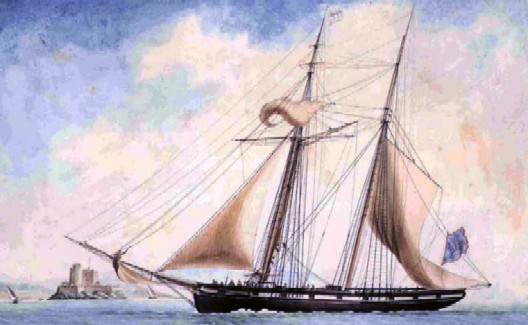
Artist: Antoine Roux - Schooner Terpsichord (1820)
Schooners make up five of the vessels found in the data, making up 5% total. They first appear as a ship type in this data around 1718 when Charles Johnson mentions that Phineas Bunce and Denis McCarty took Captain Henry White's "Batchelor’s Adventure, a Scooner"3 while on an exploratory trading voyage for Woodes Rogers' recently settled Bahamian town of New Providence. Johnson also describes this vessel as a sloop, explaining during its' capture, that the pirates "sent some Hands on board to seize his [Captain White’s] Sloop"4. However, he generally refers to this vessel as a schooner, preferring to use this term twelve different times in his text.5
The next appearance of a schooner in the pirate database is from February of 1723, when forced man Philip Ashton mentions that Edward Low's consort, captained by Francis Spriggs, had "about 22 Men on board the Schooner"6. So this vessel type only appeared in the latter part of the golden age of piracy.
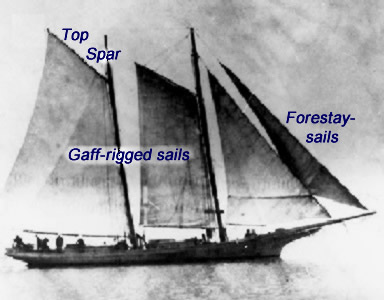
Schooner Sails of the Anna B. Smith, photographed by the navy (1915)
A schooner is a vessel which has "at least two masts, with the forward mast (foremast) being a bit shorter than the main mast. Although a schooner can have more than two masts, most were just two."7 The American Sailing Association's Website explains that while schooners had a place in history, "they were eventually all but replaced with sloops and yawls that were even better upwind and easier to manage. The schooner’s two large sails weren’t all that efficient and there was a lot of sail to deal with."8
Schooner sails can be rigged in a variety of sail configurations, but the most common is to gaff rig them - that is use four-corned sails with the top of the square being held taut by a spar (pole) which keeps it square.9 This gives the sail four-sides instead of three providing more area for the sail to catch the wind and allowing the vessel to travel faster. Bemuda-built vessels often had a mainstaysail between the two masts (not shown in the above photo) and one or two forestaysails.10
This term had more to do with the
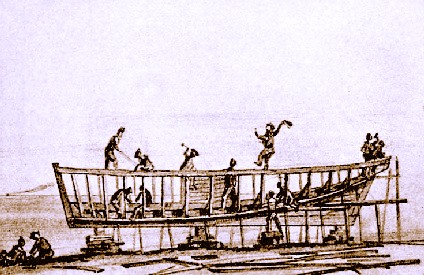
Building a Schooner, from The Last Cruise of the Saginaw
by
George H. Read, illustration by Lieutenant Commander Sicard (1912)
masts and sail plan than it did with the size or configuration of the hull of the boat. Schooner hulls would have come in a variety of different sizes. This is a something we will encounter repeatedly when trying to imagine how much space a surgeon might have aboard such a vessel.
A possible proxy for ship size was the number of guns she carried, considering that pirates would load as many guns as they possibly could onto the deck space they had. The more guns the pirates put aboard, the larger the ship. British Navy-rated schooners were recommended to have a single deck, 4-14 guns and a complement of 20-90 men.11 Of the five schooners identified in the pirate vessel data, the number of guns aboard is only indicated on one: Low's schooner Fancy. Several different sources mention the Fancy, with those noting the number of guns indicating she had between eight and ten guns mounted.12
1,2 Daniel Defoe (Captain Charles Johnson), A General History of the Pyrates, Manuel Schonhorn, ed., 1999, p. 321; 3 Defoe (Captain Charles Johnson), p. 627; 4 Defoe (Captain Charles Johnson), p. 627; 5 Defoe (Captain Charles Johnson), pp. 626, 646, 648 and 651; 6 Philip Ashton, Ashton’s Memorial of Strange Adventures and Signal Deliverance, 1726, p. 35; 7,8 Pat Reynolds, "What's in a Rig - The Schooner", American Sailing Association Website, gathered 12/22/18; 11 Gaff Rig, wikipedia, gathered 11/11/12; 11 Schooner, wikipedia, gathered 11/11/12; 11 Rating system of the Royal Navy, wikipedia, gathered 11/3/12, 1706 Establishment, wikipedia, gathered 11/14/12. and 1719 Establishment, wikipedia, gathered 11/14/12; 12 See Daily Post, 1-26-23, Issue 1039 & Philip Ashton, Ashton's Memorial of Strange Adventures and Signal Deliverance, 1726, p. 32
Pirate Vessels: Small Craft - Brigantines, Brigs and Snows
"...the Majority [of Charles Vane's pirate crew] was for boarding [a French Man-of-War - something Captain Vane opposed]... At length the Captain made use of his Power to determine this Dispute, which, in these Cases, is absolute and uncontroulable... so the [pirate's] Brigantine having the Heels... of the French Man [being faster], she came clear off." (Captain Charles Johnson, General History of the Pyrates, p. 146)
The ship in that account was Vane's brigantine Ranger. While Captain Vane won the argument about trying to take the French man of war, he lost his fast-sailing Brigantine as a result. As
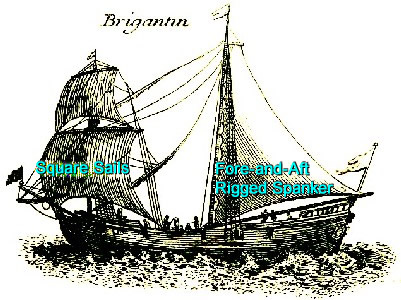
A Brigantine from Nouveau Voyage aux Isles de l'Amerique, Volume 2
by
Jean Baptiste Labat (1722). This boat has the square rigged topsail &
foresail (left) and the fore-and-aft rigged spanker (right) raised.
Johnson explains, "the next Day, the Captain's Behaviour was obliged to stand the Test of a Vote, and a ResoIution passed against his Honour and Dignity, branding him with the Name of Coward, deposing him from the Command, and turning him out of the Company, with Marks of Infamy, and, with him, went all those who did not Vote for boarding the French Man of War."1 John Rackham was made the new captain of the Ranger. However, there is apparently some honor among these thieves, however, for they gave Vane and those who chose to go with him a 'small' sloop before leaving them.
Three types of vessels were very similar to each other: brigantines, brigs and snows. Brigantines are the second most popular small pirate vessel in the data, comprising 21 vessels (21% of the small vessel data) with snows appearing near the bottom with a mere 2 vessels (2%). However, there are two 'hybrid' examples - the sloop/snow and the sloop/brigantine. These each include two examples (2% each of the small ship data). They could reasonably be added to the other data, which would result in 23% of the small vessels being brigantines and 4% of the small vessels being snows. The third term, 'brig', does not appear in the citations used to generate the data. This is probably because it did not really appear as a sail plan until the 1770s."2
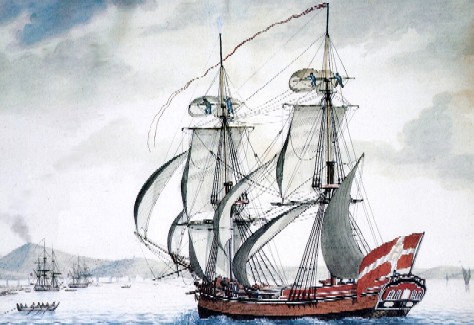
Brigantine Industria (1799)
These types of vessels were fairly popular small vessels for merchants in the West Indies - including the Caribbean and the colonies. In The Heyday of Sail: The Merchant Sailing Ship 1650 - 1830, the authors note that during the 18th century, merchant "Vessels of less than 200 tons... which were still in the majority, were two-masted and most of them were classified as brig[antine]s or snows.3
The description of these three vessels can be a bit tricky. Henry Culver warns, "Probably the name has been applied at various times to many vessels differing altogether in hull and rig."4 He also notes that "the three terms, snow, brigantine, and brig, seem at various periods to have been much confused and applied rather indiscriminately to three kinds of vessels"5. However, the key to the different appellations is generally recognized today as being the sail plan - or type of sails used to rig the ship.
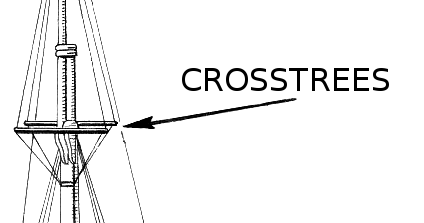
Image: Charles Brooking - Crosstrees or Trestletrees
Brigantines were originally hybrid vessels that came from the Mediterranean being "equipped with oars and usually two masts carrying lateen [triangular] sails... being able to perform equally well under either means of propulsion."6 However, by 1692, the idea of a brigantine had changed to a "well defined type of two-masted vessel probably carrying a fore and aft sail... [which] was square rigged."7 At this time, the vessel still often included oars. By the 1720s, the definition had changed again, focusing primarily on the sail plan. At this time, the ship would have square sails, being a "fully rigged two-part foremast equipped with a proper top and trestletrees [also called 'crosstrees, seen at right] carrying a course [lower sail] and topsail."8
The snow sail plan appeared at the end of the seventeenth century. On these vessels the
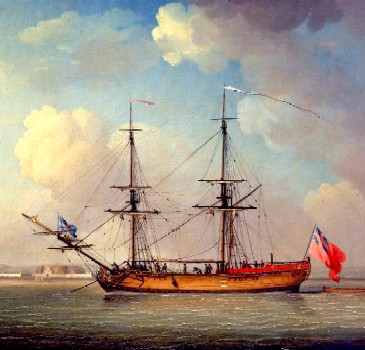
Artist: Charles Brooking
A Naval Snow Off Tilbury For (1759)
bottommost sails and the top sails were square with each mast having "a topsail, again of square proportions. A bowsprit (seen in the image above at the front of the vessel] with spritsail completed the suit."9 At the beginning of the eighteenth century, "a short ancillary mast was added immediately abaft [behind] the mainmast with its head [top] secured to the mainmast top platform and its base to the deck."10
Although the brig (a term likely derived by shortening 'brigantine') is not really a vessel of concern to this study, "the brig rig used a shorter [than the brigantine] lower mainmast with a proper top and platform.... the whole mast being fully square rigged. Additionally, in most conditions instead of a square main course [the lowest sail on a mast], there was a... fore-and-aft sail abaft [behind] the lower mainmast... [of a] much shorter luff [edge] than that of a true brigantine."11
While these definitions contain a lot of terminology and can be somewhat difficult to understand for those not well versed in sailing ship terms, the actual differences between them are slight on a vessel as can be seen in the comparison images below.
 Fulling Rigged Brigantine, Brig and Snow Sail Plans |
Angus Konstam suggests that 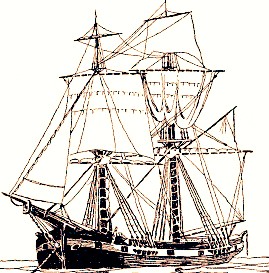
Artist: Ray Brown
A Merchant Snow from American Merchant Ships
and
Sailors by Willis J. Abbot, p. 29 (1902)
brigantines and snows "lacked the high proportion of sail area to displacement that characterized the sloop, and to a lesser extent the faster square-rigged ships of the period such as slavers"12. While pirates used them, they were much less popular than sloops as our listing of vessel types at the top of this page suggests.
For armament, the Navy recommended that Brigantines carry 4 - 14 guns and 20-90 men to man them.13 The brigantines found in the pirate data included a wide range of gun numbers. For brigantines, there number of guns ran the gamut: ships like Edward Low's Rebecca reportedly mounted only 2 guns14, while John Fenn's consort brigantine Antelope which mounted 34 guns at the height of its power.15 This large difference is probably best explained by differences in hull size. However, most of the brigantines in the data mounted between 10 and 18 guns, similar to the numbers suggested by the Royal Navy.
Brigs were sometimes created from other small vessels. When John Bowen's pirate crew were on the island of Mauritius in March of 1702, "they bought a sloop, which they converted into a Brigantine" by adding a second mast15. Such an addition would have further limited the space below decks where the surgeon worked.
1 Daniel Defoe (Captain Charles Johnson), A General History of the Pyrates, Manuel Schonhorn, ed., 1999, p. 139; 2 Ian Mclaughlan, The Sloop of War: 1650-1763, 2014, p. 26; 2 The Heyday of Sail: The Merchant Sailing Ship 1650 - 1830, Robert Gardiner, ed., 1992, p. 27; 6 Mclaughlan, p. 24; 7 Henry Culver, The Book of Old Ships, 1924, p. 239; 8 Mclaughlan, p. 24; 9,10 Mclaughlan, p. 25; 11 Mclaughlan, p. 26; 12Angus Konstam, The Pirate Ship 1660 -1730, p. 21; 13 Rating system of the Royal Navy, wikipedia, gathered 11/3/12; 14 American Weekly Mercury, Vol 1, 1719-1720, The Colonial Society of Pennsylvania, 1898, p. 73; 15 American Weekly Mercury, Vol 4, 1722-1723, The Colonial Society of Pennsylvania, 1907; 15 Defoe (Captain Charles Johnson), p. 733

